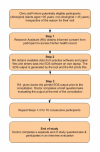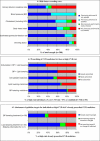An electronic clinical decision support tool to assist primary care providers in cardiovascular disease risk management: development and mixed methods evaluation
- PMID: 20018588
- PMCID: PMC2802562
- DOI: 10.2196/jmir.1258
An electronic clinical decision support tool to assist primary care providers in cardiovascular disease risk management: development and mixed methods evaluation
Abstract
Background: Challenges remain in translating the well-established evidence for management of cardiovascular disease (CVD) risk into clinical practice. Although electronic clinical decision support (CDS) systems are known to improve practitioner performance, their development in Australian primary health care settings is limited.
Objectives: Study aims were to (1) develop a valid CDS tool that assists Australian general practitioners (GPs) in global CVD risk management, and (2) preliminarily evaluate its acceptability to GPs as a point-of-care resource for both general and underserved populations.
Methods: CVD risk estimation (based on Framingham algorithms) and risk-based management advice (using recommendations from six Australian guidelines) were programmed into a software package. Tool validation: Data from 137 patients attending a physician's clinic were analyzed to compare the tool's risk scores with those obtained from an independently programmed algorithm in a separate statistics package. The tool's management advice was compared with a physician's recommendations based on a manual review of the guidelines. Field test: The tool was then tested with 21 GPs from eight general practices and three Aboriginal Medical Services. Customized CDS-based recommendations were generated for 200 routinely attending patients (33% Aboriginal) using information extracted from the health record by a research assistant. GPs reviewed these recommendations during each consultation. Changes in CVD risk factor measurement and management were recorded. In-depth interviews with GPs were conducted.
Results: Validation testing: the tool's risk assessment algorithm correlated very highly with the independently programmed version in the separate statistics package (intraclass correlation coefficient 0.999). For management advice, there were only two cases of disagreement between the tool and the physician. Field test: GPs found 77% (153/200) of patient outputs easy to understand and agreed with screening and prescribing recommendations in 72% and 64% of outputs, respectively; 26% of patients had their CVD risk factor history updated; 73% had at least one CVD risk factor measured or tests ordered. For people assessed at high CVD risk (n = 82), 10% and 9%, respectively, had lipid-lowering and BP-lowering medications commenced or dose adjustments made, while 7% newly commenced anti-platelet medications. Three key qualitative findings emerged: (1) GPs found the tool enabled a systematic approach to care; (2) the tool greatly influenced CVD risk communication; (3) successful implementation into routine care would require integration with practice software, minimal data entry, regular revision with updated guidelines, and a self-auditing feature. There were no substantive differences in study findings for Aboriginal Medical Services GPs, and the tool was generally considered appropriate for use with Aboriginal patients.
Conclusion: A fully-integrated, self-populating, and potentially Internet-based CDS tool could contribute to improved global CVD risk management in Australian primary health care. The findings from this study will inform a large-scale trial intervention.
Conflict of interest statement
None to declare
Figures
References
-
- Australian Institute of Health and Welfare (AIHW), authors Australia’s Health 2008. Cat. no. AUS 99. Canberra, Australia: AIHW; 2008.
-
- Vos T, Barker B, Stanley L, Lopez AD. The burden of disease and injury in Aboriginal and Torres Strait Islander peoples 2003. Brisbane, Australia: University of Queensland; 2007. - PubMed
-
- Antithrombotic Trialists' Collaboration. Collaborative meta-analysis of randomised trials of antiplatelet therapy for prevention of death, myocardial infarction, and stroke in high risk patients. BMJ. 2002 Jan 12;324(7329):71–86. doi: 10.1136/bmj.324.7329.71. http://bmj.com/cgi/pmidlookup?view=long&pmid=11786451 - DOI - PMC - PubMed
Publication types
MeSH terms
LinkOut - more resources
Full Text Sources





